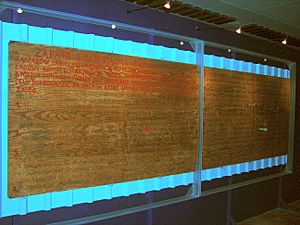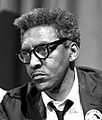Tom Kahn facts for kids
Quick facts for kids
Tom Kahn
|
|
|---|---|
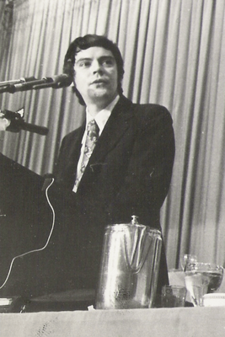
Tom Kahn, Director of the Department of International Affairs for the AFL–CIO 1986–1992
|
|
| Born |
Thomas John Marcel
September 15, 1938 |
| Died | March 27, 1992 (aged 53) |
| Other names | T. Kahn, Thomas David Kahn Tom Marcel |
| Organization | Congress of Racial Equality (CORE) League for Industrial Democracy, (LID) (Director) Social Democrats, USA (SDUSA) AFL–CIO's Department of International Affairs (Director) |
| Movement | Civil Rights Movement, American social democracy, American labor, Democracy |
Tom David Kahn (September 15, 1938 – March 27, 1992) was an important American leader. He was known for his work in several organizations. Tom Kahn was a key activist and planner in the Civil Rights Movement. He also became a senior advisor in the U.S. labor movement.
Kahn grew up in New York City. At Brooklyn College, he joined the U.S. socialist movement. There, he was inspired by leaders like Max Shachtman and Michael Harrington. As an assistant to civil rights leader Bayard Rustin, Kahn helped organize the famous 1963 March on Washington. This was where Martin Luther King Jr. gave his "I Have a Dream" speech. Kahn's ideas about civil rights greatly influenced Bayard Rustin.
Kahn was a leader in the Socialist Party of America. He supported its name change in 1972 to Social Democrats, USA (SDUSA). Like other SDUSA leaders, Kahn worked to support free labor unions and democracy. He also worked to oppose Soviet communism and make U.S. labor unions stronger. Kahn was a senior assistant and speechwriter for many important people. These included Senator Henry "Scoop" Jackson and AFL–CIO Presidents George Meany and Lane Kirkland.
In 1980, Lane Kirkland asked Kahn to help the Polish labor union Solidarity. Kahn organized support for them, even though the USSR and the Carter administration protested. He became the Director of the AFL–CIO's Department of International Affairs in 1986. He was officially named Director in 1989. Tom Kahn passed away in 1992 when he was 53 years old.
Contents
Tom Kahn's Life Story
Early Years
Tom Kahn was born Thomas John Marcel on September 15, 1938. He was adopted by Adele and David Kahn and renamed Thomas David Kahn. His father was a member of the Communist Party USA. He became president of a local union for the Brooklyn Union Gas Company.
Tom Kahn was a strong believer in freedom. In high school, he ran for student president. He wanted to change the student assembly because it had no real power. He lost that election. In high school, he also met Rachelle Horowitz. She became his close friend and political partner for life.
Joining the Socialist Movement
At Brooklyn College (CUNY), Tom Kahn and Rachelle Horowitz became interested in democratic socialism. They were inspired after hearing Max Shachtman speak about the 1956 Soviet invasion of Hungary. Shachtman explained how Russian tanks crushed the hopes of Hungarian workers and students. He taught them that freedom and democracy were real and could be destroyed.
Kahn and Horowitz learned that democracy was essential for socialism. They believed that if socialism was worth fighting for in America, it was worth fighting for everywhere. This made them strong supporters of international cooperation.
Their talents were noticed by Michael Harrington. Harrington later became famous for his book The Other America, which was about poverty in the United States. Kahn looked up to Harrington for his knowledge and speaking skills.
Working for Civil Rights
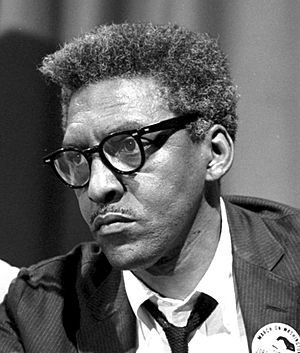
Michael Harrington, a leader in the American socialist movement, sent Tom Kahn and Rachelle Horowitz to help Bayard Rustin. Rustin was a key leader of the Civil Rights Movement. He became a mentor to Kahn. Kahn and Horowitz were sometimes called the "Bayard Rustin Marching and Chowder Society."
Kahn helped Rustin organize several important events. These included the 1957 Prayer Pilgrimage to Washington. He also helped with the 1958 and 1959 Youth Marches for Integrated Schools.
Kahn and Bayard Rustin
Tom Kahn and Bayard Rustin became very close friends and political partners. They shared a deep commitment to social justice. Kahn later remembered Rustin as someone who taught him about the importance of balancing personal life with social responsibility.
Time at Howard University
Kahn, who was white, attended Howard University for his last two years of college. Howard is a historically black university. He became a leader in student politics there. Kahn worked closely with Stokely Carmichael, who later became a national civil rights leader.
Kahn and Carmichael worked together on projects, including funding a play. They also worked with Howard University's chapter of the Student Nonviolent Coordinating Committee (SNCC). Kahn introduced Carmichael and other SNCC activists to Bayard Rustin. Rustin became an important advisor to SNCC. Kahn and Rustin's focus on economic fairness influenced Carmichael. Kahn graduated from Howard in 1961.
Leading the March on Washington
Kahn, along with Horowitz and Norman Hill, helped Rustin and A. Philip Randolph plan the 1963 March on Washington. This was the march where Martin Luther King Jr. gave his famous "I Have a Dream" speech. Kahn also wrote the speech for A. Philip Randolph, a senior leader in the civil rights and labor movements. Kahn's ideas about the civil rights movement influenced many, including Bayard Rustin and Stokely Carmichael.
Working for Industrial Democracy
After 1964, Kahn became the Director of the League for Industrial Democracy (LID). He wrote many pamphlets for LID, which were published in political magazines. One of his pamphlets, The Economics of Equality, offered a strong analysis of how to end racial unfairness.
Students for a Democratic Society (SDS)
Before becoming LID director, Kahn was involved with the Student League for Industrial Democracy. This group later became Students for a Democratic Society (SDS). Kahn and other LID members attended a meeting where they discussed the Port Huron Statement. This statement was a key document for SDS.
LID representatives, including Kahn, criticized the Port Huron Statement. They felt it made students too central to social change. They also disagreed with its criticisms of the U.S. labor movement and its views on Soviet communism. Kahn believed some SDS students were "elitist" and too critical of labor unions.
LID and SDS separated in 1965. SDS voted to remove a rule that stopped communists from joining. Kahn argued against this. He believed removing the rule would allow groups to try and take over SDS. After this, some groups, like the Progressive Labor Party, caused problems for SDS. Kahn continued to debate SDS leaders about leadership and strategy.
Social Democrats, USA
Kahn and Horowitz were leaders in the Socialist Party USA. They supported its name change to Social Democrats, USA (SDUSA).
Ben Wattenberg noted that SDUSA members, including Kahn, worked hard to challenge the Soviet Union. They created many small organizations, all with similar goals. Wattenberg said they "talked and wrote endlessly, mostly about communism and democracy, despising the former, adoring the latter." Kahn believed that to truly support democracy, one must also oppose communism.
Kahn worked as a senior assistant and speechwriter for important figures. These included Senator Henry "Scoop" Jackson, and AFL–CIO Presidents George Meany and Lane Kirkland. He was a very good speechwriter because he could explain complex ideas clearly to an American audience.
AFL–CIO and Global Support
After becoming an assistant to the President of the AFL–CIO in 1972, Kahn became an expert in international affairs. In 1980, AFL–CIO leader Lane Kirkland asked Kahn to organize support for the Polish labor union Solidarity. This support continued and even grew, despite protests from the USSR and the Carter administration.
Helping Polish Solidarity
Tom Kahn was very involved in supporting the Polish labor movement. The trade union Solidarity (Solidarność) started in 1980. The Communist government in Poland declared martial law in December 1981.
AFL–CIO President Lane Kirkland asked Kahn to organize support for Solidarity. The AFL–CIO made sure to get approval from Solidarity's leaders first. This ensured their help was welcome and useful. The AFL–CIO supported Solidarity's twenty-one demands. They lobbied the U.S. government to stop loans to Poland unless these demands were met.
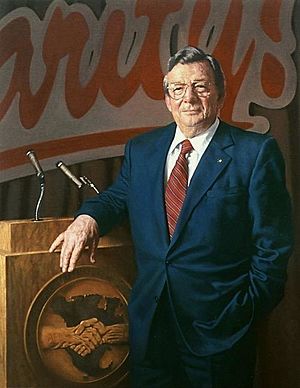
The AFL–CIO also created the Polish Workers Aid Fund. By 1981, it had raised almost $300,000. This money was used to buy printing presses, office supplies, typewriters, and other items Solidarity requested.
Kahn explained that the AFL–CIO's support angered the Communist governments. The Soviet Union and other Eastern European countries launched a huge propaganda attack against the AFL–CIO. The Carter Administration was also worried. Secretary of State Edmund Muskie told Kirkland that continued support for Solidarity could lead to a Soviet invasion of Poland. However, Kirkland refused to stop the support.
The AFL–CIO's independent support for Solidarity was very successful. By 1984, both Democrats and Republicans in the U.S. agreed it was a good idea. They decided that public support for such groups was appropriate for a democracy. The National Endowment for Democracy (NED) was created. Through NED, Congress openly funded Solidarity starting in 1984. From 1984 to 1990, NED and the AFL–CIO sent $4 million in equipment and support to Solidarity.
Leading International Affairs
In 1986, Kahn became the Director of the AFL–CIO Department of International Affairs. He worked to create a unified foreign policy for the organization. He helped write resolutions that represented the agreement of nearly all member unions.
Kahn became acting Director in 1986 after Irving Brown resigned due to illness. After Brown's death in 1989, Kahn was officially named the Director.
Later Life and Legacy
In 1986, Tom Kahn learned he was infected with human immunodeficiency virus (HIV). At that time, this was a very serious diagnosis. Despite this, he accepted the role of Director out of a sense of duty. He knew the job would be very demanding. He told his co-workers about his health condition and asked them to watch for any signs of decline.
Tom Kahn passed away from acquired immunodeficiency syndrome (AIDS) in Silver Spring, Maryland on March 27, 1992. He was 53 years old. He was cared for by his partner and supported by his friends and colleagues. Kahn planned most of his own memorial service, which was held at the AFL–CIO headquarters.
Images for kids


